Assessing the Water Status and Leaf Pigment Content of Olive Trees: Evaluating the Potential and Feasibility of Unmanned Aerial Vehicle Multispectral and Thermal Data for Estimation Purposes
Abstract
:1. Introduction
2. Materials and Methods
2.1. Study Site, Climate and Soil Characterisation
2.2. Irrigation Treatments and Experimental Design
2.3. Soil Water Content and Plant Water Status Indicator Measurements
2.4. Quantification of Chlorophyll a, b and Total Carotenoid Pigment Content
2.5. Remote Sensing Data Collection
2.6. UAV Data Processing
2.7. Imagery Segmentation
2.8. Design of the Statistical Analysis and Regression Model Assessment
3. Results
3.1. Soil Water Content
3.2. Water Stress Indicators
3.3. Leaf Pigment Content
3.4. Modelling the Water Stress Indicators and Pigment Content
3.4.1. Model Development
3.4.2. Model Application
4. Discussion
4.1. Effects of Water Stress on Pigment Content
4.2. Effects of Water Stress on Leaf Reflectance and Vegetation Indices
4.3. Model Performance in Estimating the Water Status Indicators
4.4. Model Performance in Estimating the Pigment Content
5. Conclusions
Author Contributions
Funding
Data Availability Statement
Acknowledgments
Conflicts of Interest
Appendix A
| Acronym | Name | Sensitivity | Equation | Ref. |
|---|---|---|---|---|
| ACI | Anthocyanin Content Index | Carotenoid | [73] | |
| ARI | Anthocyanin Reflectance Index | Carotenoid | [74] | |
| ATSAVI | Adjusted Transformed Soil-Adjusted Vegetation Index | Structure | [75] | |
| BRI | Browning Reflectance Index | Dry matter/pigment | [76] | |
| CCCI | Canopy Chlorophyll Content Index | Chlorophyll | [77] | |
| CIG | Chlorophyll Index Green | Chlorophyll | [78] | |
| CIRE | Chlorophyll Index RedEdge | Chlorophyll | [79] | |
| CVI | Chlorophyll Vegetation Index | Chlorophyll | [80] | |
| DVI | Difference Vegetation Index | Structure | [81] | |
| EVI2 | Enhanced Vegetation Index 2 | Structure | [82] | |
| eNIR | Excess NIR | Structure | [83] | |
| eRE | Excess RedEdge | Structure | [83] | |
| GDVI | Green Difference Vegetation Index | Structure | [84] | |
| GM1 | Gitelson and Merzlyak Index | Chlorophyll | [85] | |
| GNDVI | Green Normalised Difference Vegetation Index | Chlorophyll | [86] | |
| GRNDVI | Green–Red NDVI | Structure | [87] | |
| GRVI | Green–Red Vegetation Index | Structure | [81] | |
| GSAVI | Green Soil-Adjusted Vegetation Index | Structure | [84] | |
| IPVI | Infrared Percentage Vegetation Index | Structure | [88] | |
| mACI | Modified Anthocyanin Content Index | Carotenoid | [89] | |
| MCARI | Modified Chlorophyll Absorption in Reflectance Index | Chlorophyll | [42] | |
| MCARI1 | Modified Chlorophyll Absorption in Reflectance Index 1 | Structure | [90] | |
| MCARI2 | Modified Chlorophyll Absorption in Reflectance Index 2 | Structure | [90] | |
| mGRVI | Modified Green Red Vegetation Index | Structure | [26] | |
| MSAVI | Modified Soil-Adjusted Vegetation Index | Structure | [91] | |
| MSR N/R | Modified Simple Ratio NIR/RED | Structure | [92] | |
| MTVI1 | Modified Triangular Vegetation Index 1 | Structure | [90] | |
| NDExNIR | Normalised Difference Excess NIR | Structure | [83] | |
| NDExRE | Normalised Difference Excess Red Edge | Structure | [83] | |
| NDRE | Normalised Difference NIR/RedEdge | Structure | [77] | |
| NDVI | Normalised Difference Vegetation Index | Structure | [40] | |
| OSAVI | Optimised Soil-Adjusted Vegetation Index | Structure | [43] | |
| RGI | Red Green Index | Dry matter/pigment | [93] | |
| SAVI | Soil-Adjusted Vegetation Index | Structure | [94] | |
| TNDVI | Transformed NDVI | Structure | [81] | |
| TVI | Triangular Vegetation Index | Chlorophyll | [95] | |
| WDRVI | Wide Dynamic Range Vegetation Index | Structure | [96] |
Appendix B
| VIs | RWC | gs | ΨMD | Chl a | Chl b | Chl ab | Carotenoids |
|---|---|---|---|---|---|---|---|
| ACI | 0.15 | 0.36 | 0.38 | 0.09 | 0.04 | 0.08 | 0.02 |
| ARI | 0.14 | 0.01 | 0.08 | 0.09 | 0.09 | 0.11 | 0.07 |
| ATSAVI | 0.17 | 0.66 | 0.30 | 0.40 | 0.44 | 0.48 | 0.32 |
| BRI | 0.07 | 0.30 | 0.14 | 0.08 | 0.08 | 0.10 | 0.07 |
| CCCI | 0.02 | 0.64 | 0.07 | 0.30 | 0.18 | 0.28 | 0.06 |
| CIG | 0.14 | 0.44 | 0.40 | 0.05 | 0.03 | 0.05 | 0.08 |
| CIRE | 0.02 | 0.57 | 0.04 | 0.13 | 0.05 | 0.10 | 0.01 |
| CVI | 0.23 | 0.27 | 0.36 | 0.14 | 0.09 | 0.14 | 0.04 |
| DVI | 0.21 | 0.63 | 0.35 | 0.38 | 0.41 | 0.46 | 0.33 |
| EVI2 | 0.20 | 0.65 | 0.33 | 0.41 | 0.43 | 0.49 | 0.34 |
| eNIR | 0.12 | 0.21 | 0.37 | 0.09 | 0.11 | 0.11 | 0.10 |
| eRE | 0.03 | 0.71 | 0.30 | 0.13 | 0.17 | 0.15 | 0.05 |
| GDVI | 0.18 | 0.66 | 0.33 | 0.32 | 0.36 | 0.39 | 0.31 |
| GM1 | 0.08 | 0.68 | 0.34 | 0.09 | 0.09 | 0.09 | 0.05 |
| GNDVI | 0.15 | 0.38 | 0.39 | 0.14 | 0.04 | 0.11 | 0.05 |
| GRNDVI | 0.08 | 0.47 | 0.37 | 0.12 | 0.15 | 0.14 | 0.10 |
| GRVI | 0.30 | 0.02 | 0.10 | 0.01 | 0.11 | 0.03 | 0.02 |
| GSAVI | 0.14 | 0.69 | 0.29 | 0.31 | 0.34 | 0.37 | 0.29 |
| IPVI | 0.01 | 0.48 | 0.26 | 0.33 | 0.24 | 0.33 | 0.19 |
| mACI | 0.14 | 0.43 | 0.40 | 0.09 | 0.03 | 0.07 | 0.02 |
| MCARI | 0.58 | 0.18 | 0.29 | 0.58 | 0.59 | 0.66 | 0.31 |
| MCARI1 | 0.25 | 0.60 | 0.36 | 0.41 | 0.43 | 0.49 | 0.32 |
| MCARI2 | 0.21 | 0.62 | 0.32 | 0.40 | 0.44 | 0.48 | 0.33 |
| mGRVI | 0.30 | 0.02 | 0.10 | 0.12 | 0.17 | 0.16 | 0.07 |
| MSAVI | 0.20 | 0.64 | 0.33 | 0.40 | 0.44 | 0.49 | 0.33 |
| MSR N/R | 0.01 | 0.49 | 0.26 | 0.33 | 0.32 | 0.36 | 0.21 |
| MTVI1 | 0.25 | 0.60 | 0.36 | 0.41 | 0.43 | 0.49 | 0.32 |
| NDExNIR | 0.13 | 0.08 | 0.33 | 0.09 | 0.10 | 0.10 | 0.10 |
| NDExRE | 0.02 | 0.70 | 0.29 | 0.13 | 0.17 | 0.15 | 0.06 |
| NDRE | 0.03 | 0.59 | 0.04 | 0.16 | 0.06 | 0.13 | 0.02 |
| NDVI | 0.03 | 0.47 | 0.26 | 0.33 | 0.27 | 0.35 | 0.21 |
| OSAVI | 0.18 | 0.68 | 0.29 | 0.43 | 0.42 | 0.49 | 0.32 |
| RGI | 0.29 | 0.04 | 0.10 | 0.30 | 0.18 | 0.29 | 0.14 |
| SAVI | 0.19 | 0.66 | 0.32 | 0.42 | 0.44 | 0.50 | 0.34 |
| TNDVI | 0.02 | 0.47 | 0.26 | 0.27 | 0.16 | 0.26 | 0.15 |
| TVI | 0.42 | 0.46 | 0.43 | 0.68 | 0.55 | 0.73 | 0.37 |
| WDRVI | 0.03 | 0.49 | 0.26 | 0.32 | 0.32 | 0.36 | 0.19 |
| VIs | RWC | gs | ΨMD | Chl a | Chl b | Chl ab | Carotenoids |
|---|---|---|---|---|---|---|---|
| CWSI1 | 0.85 | 0.80 | 0.66 | 0.28 | 0.27 | 0.24 | 0.06 |
| CWSI2 | 0.74 | 0.76 | 0.58 | 0.29 | 0.25 | 0.26 | 0.05 |
| CWSI3 | 0.70 | 0.75 | 0.58 | 0.27 | 0.25 | 0.24 | 0.04 |
| CWSI4 | 0.66 | 0.75 | 0.50 | 0.23 | 0.21 | 0.21 | 0.03 |
| CWSI5 | 0.68 | 0.77 | 0.51 | 0.20 | 0.19 | 0.17 | 0.02 |
| Ig1 | 0.38 | 0.57 | 0.34 | 0.08 | 0.06 | 0.13 | 0.01 |
| Ig2 | 0.43 | 0.63 | 0.46 | 0.07 | 0.06 | 0.09 | 0.01 |
| Ig3 | 0.42 | 0.67 | 0.45 | 0.07 | 0.06 | 0.08 | 0.01 |
References
- World Economic Forum. Global Risks 2015. 10th Edition. Available online: https://www3.weforum.org/docs/WEF_Global_Risks_2015_Report15.pdf (accessed on 15 May 2023).
- Rosa, L.; Chiarelli, D.D.; Rulli, M.C.; Dell’Angelo, J.; D’Odorico, P. Global agricultural economic water scarcity. Sci. Adv. 2020, 6, 6031. [Google Scholar] [CrossRef] [PubMed]
- Liang, Z.; Liu, X.; Xiong, J.; Xiao, J. Water Allocation and Integrative Management of Precision Irrigation: A Systematic Review. Water 2020, 12, 3135. [Google Scholar] [CrossRef]
- Serra, P.; Pons, X. Two Mediterranean irrigation communities in front of water scarcity: A comparison using satellite image time series. J. Arid Environ. 2013, 98, 41–51. [Google Scholar] [CrossRef]
- Gucci, R.; Caruso, G.; Gennai, C.; Esposto, S.; Urbani, S.; Servili, M. Fruit growth, yield and oil quality changes induced by deficit irrigation at different stages of olive fruit development. Agric. Water Manag. 2019, 212, 88–98. [Google Scholar] [CrossRef]
- Fernandes-Silva, A.; Gouveia, J.; Vasconcelos, P.; Ferreira, T.C.; Villalobos, F.J. Effect of different irrigation regimes on the quality attributes of monovarietal virgin olive oil from cv. “Cobrançosa”. Grasas Aceites 2013, 64, 41–49. [Google Scholar] [CrossRef]
- Serman, F.V.; Pacheco, D.; Pringles, A.O.; Bueno, L.; Carelli, A.; Capraro, F. Effect of regulated deficit irrigation strategies on productivity, quality and water use efficiency in a high-density “Arbequina” olive orchard located in an arid region of Argentina. Acta Hort 2011, 888, 81–88. [Google Scholar] [CrossRef]
- Shackel, K.; Moriana, A.; Marino, G.; Corell González, M.; Pérez-López, D.; Martín Palomo, M.J.; Caruso, T.; Marra, F.P.; Agüero Alcaras, L.M.; Milliron, L.; et al. Establishing a Reference Baseline for Midday Stem Water Potential in Olive and Its Use for Plant-Based Irrigation Management. Front. Plant Sci. 2021, 12, 2715. [Google Scholar] [CrossRef]
- Trentacoste, E.R.; Calderón, F.J.; Contreras-Zanessi, O.; Galarza, W.; Banco, A.P.; Puertas, C.M. Effect of regulated deficit irrigation during the vegetative growth period on shoot elongation and oil yield components in olive hedgerows (cv. Arbosana) pruned annually on alternate sides in San Juan, Argentina. Irrig. Sci. 2019, 37, 533–546. [Google Scholar] [CrossRef]
- Fernandes-Silva, A.A.; Ferreira, T.C.; Correia, C.M.; Malheiro, A.C.; Villalobos, F.J. Influence of different irrigation regimes on crop yield and water use efficiency of olive. Plant Soil 2010, 333, 35–47. [Google Scholar] [CrossRef]
- Fernández, J.E.; Perez-Martin, A.; Torres-Ruiz, J.M.; Cuevas, M.V.; Rodriguez-Dominguez, C.M.; Elsayed-Farag, S.; Morales-Sillero, A.; García, J.M.; Hernandez-Santana, V.; Diaz-Espejo, A. A regulated deficit irrigation strategy for hedgerow olive orchards with high plant density. Plant Soil 2013, 372, 279–295. [Google Scholar] [CrossRef]
- Fernandes-Silva, A.; Canas, L.; Brito, T.; Marques, P. Regulated and sustained deficit irrigation: Impacts on yield components of olive trees. In Proceedings of the IV International Symposium on Horticulture in Europe-SHE2021, Stuttgart, Germany, 2–6 June 2021; pp. 261–268. [Google Scholar]
- Lichtenthaler, H.K. The Stress Concept in Plants: An Introduction. Ann. N. Y. Acad. Sci. 1998, 851, 187–198. [Google Scholar] [CrossRef] [PubMed]
- Wu, C.; Niu, Z.; Tang, Q.; Huang, W. Estimating chlorophyll content from hyperspectral vegetation indices: Modeling and validation. Agric. For. Meteorol. 2008, 148, 1230–1241. [Google Scholar] [CrossRef]
- Gitelson, A.A.; Keydan, G.P.; Merzlyak, M.N. Three-band model for noninvasive estimation of chlorophyll, carotenoids, and anthocyanin contents in higher plant leaves. Geophys. Res. Lett. 2006, 33, 11. [Google Scholar] [CrossRef]
- Pádua, L.; Vanko, J.; Hruška, J.; Adão, T.; Sousa, J.J.; Peres, E.; Morais, R. UAS, sensors, and data processing in agroforestry: A review towards practical applications. Int. J. Remote Sens. 2017, 38, 2349–2391. [Google Scholar] [CrossRef]
- Herwitz, S.R.; Johnson, L.F.; Dunagan, S.E.; Higgins, R.G.; Sullivan, D.V.; Zheng, J.; Lobitz, B.M.; Leung, J.G.; Gallmeyer, B.A.; Aoyagi, M.; et al. Imaging from an unmanned aerial vehicle: Agricultural surveillance and decision support. Comput. Electron. Agric. 2004, 44, 49–61. [Google Scholar] [CrossRef]
- Marques, P.; Carvalho, R.; Fernandes-Silva, A. Preliminary Assessment of the Relationship between Pigments in Olive Leaves and Vegetation Indices. Proc. Latv. Acad. Sci. Sect. B Nat. Exact Appl. Sci. 2022, 76, 517–525. [Google Scholar] [CrossRef]
- Marques, P.; Pádua, L.; Adão, T.; Hruška, J.; Peres, E.; Sousa, A.; Sousa, J.J. UAV-Based Automatic Detection and Monitoring of Chestnut Trees. Remote Sens. 2019, 11, 855. [Google Scholar] [CrossRef]
- Zhou, J.-J.; Zhang, Y.-H.; Han, Z.-M.; Liu, X.-Y.; Jian, Y.-F.; Hu, C.-G.; Dian, Y.-Y. Evaluating the Performance of Hyperspectral Leaf Reflectance to Detect Water Stress and Estimation of Photosynthetic Capacities. Remote Sens. 2021, 13, 2160. [Google Scholar] [CrossRef]
- Pádua, L.; Matese, A.; Di Gennaro, S.F.; Morais, R.; Peres, E.; Sousa, J.J. Vineyard classification using OBIA on UAV-based RGB and multispectral data: A case study in different wine regions. Comput. Electron. Agric. 2022, 196, 106905. [Google Scholar] [CrossRef]
- Mangus, D.L.; Sharda, A.; Zhang, N. Development and evaluation of thermal infrared imaging system for high spatial and temporal resolution crop water stress monitoring of corn within a greenhouse. Comput. Electron. Agric. 2016, 121, 149–159. [Google Scholar] [CrossRef]
- Franch, B.; Vermote, E.F.; Skakun, S.; Roger, J.C.; Becker-Reshef, I.; Murphy, E.; Justice, C. Remote sensing based yield monitoring: Application to winter wheat in United States and Ukraine. Int. J. Appl. Earth Obs. Geoinf. 2019, 76, 112–127. [Google Scholar] [CrossRef]
- Adeyemi, O.; Grove, I.; Peets, S.; Domun, Y.; Norton, T. Dynamic modelling of the baseline temperatures for computation of the crop water stress index (CWSI) of a greenhouse cultivated lettuce crop. Comput. Electron. Agric. 2018, 153, 102–114. [Google Scholar] [CrossRef]
- Caturegli, L.; Matteoli, S.; Gaetani, M.; Grossi, N.; Magni, S.; Minelli, A.; Corsini, G.; Remorini, D.; Volterrani, M. Effects of water stress on spectral reflectance of bermudagrass. Sci. Rep. 2020, 10, 15055. [Google Scholar] [CrossRef] [PubMed]
- Bendig, J.; Yu, K.; Aasen, H.; Bolten, A.; Bennertz, S.; Broscheit, J.; Gnyp, M.L.; Bareth, G. Combining UAV-based plant height from crop surface models, visible, and near infrared vegetation indices for biomass monitoring in barley. Int. J. Appl. Earth Obs. Geoinf. 2015, 39, 79–87. [Google Scholar] [CrossRef]
- Stillitano, T.; de Luca, A.I.; Falcone, G.; Spada, E.; Gulisano, G.; Strano, A. Economic profitability assessment of Mediterranean olive growing systems. Bulg. J. Agric. Sci. 2016, 22, 517–526. [Google Scholar]
- Instituto Nacional de Estatística (INE). EstatísticasAgrícolas 2020, 1st ed.; INE: Lisboa, Portugal, 2020. [Google Scholar]
- International Olive Council (IOC). Determination of Biophenols in Olive Oil by HPLC. COI/T.20/Doc. No. 29 Rev. 1; International Olive Council (IOC): Madrid, Spain, 2017; Available online: https://www.internationaloliveoil.org/wp-content/uploads/2019/11/COI-T.20-Doc.-No-29-Rev-1-2017.pdf (accessed on 23 May 2023).
- Gimenez, C.; Fereres, E.; Ruz, C.; Orgaz, F. Water relations and gas exchange of olive trees: Diurnal and seasonal patterns of leaf water potential, photosynthesis and stomatal conductance. In Proceedings of the II International Symposium on Irrigation of Horticultural Crops, Crete, Greece, 1 August 1997; pp. 411–416. [Google Scholar]
- Villalobos, F.J.; Testi, L.; Hidalgo, J.; Pastor, M.; Orgaz, F. Modelling potential growth and yield of olive (Olea europaea L.) canopies. Eur. J. Agron. 2006, 24, 296–303. [Google Scholar] [CrossRef]
- López-Bernal, Á.; Fernandes-Silva, A.A.; Vega, V.A.; Hidalgo, J.C.; León, L.; Testi, L.; Villalobos, F.J. A fruit growth approach to estimate oil content in olives. Eur. J. Agron. 2021, 123, 126206. [Google Scholar] [CrossRef]
- Marques, P.; Pádua, L.; Brito, T.; Sousa, J.J.; Fernandes-Silva, A. Monitoring of Olive Trees Temperatures under Different Irrigation Strategies by UAV Thermal Infrared Imagery. In Proceedings of the IGARSS 2020-2020 IEEE International Geoscience and Remote Sensing Symposium, Virtual Symposium, Waikoloa, HI, USA, 26 September–2 October 2020; pp. 4550–4553. [Google Scholar]
- Egea, G.; Padilla-Díaz, C.M.; Martinez-Guanter, J.; Fernández, J.E.; Pérez-Ruiz, M. Assessing a crop water stress index derived from aerial thermal imaging and infrared thermometry in super-high density olive orchards. Agric. Water Manag. 2017, 187, 210–221. [Google Scholar] [CrossRef]
- Ben-Gal, A.; Agam, N.; Alchanatis, V.; Cohen, Y.; Yermiyahu, U.; Zipori, I.; Presnov, E.; Sprintsin, M.; Dag, A. Evaluating water stress in irrigated olives: Correlation of soil water status, tree water status, and thermal imagery. Irrig. Sci. 2009, 27, 367–376. [Google Scholar] [CrossRef]
- Caruso, G.; Palai, G.; Tozzini, L.; Gucci, R. Using Visible and Thermal Images by an Unmanned Aerial Vehicle to Monitor the Plant Water Status, Canopy Growth and Yield of Olive Trees (cvs. Frantoio and Leccino) under Different Irrigation Regimes. Agronomy 2022, 12, 1904. [Google Scholar] [CrossRef]
- Marino, G.; Pallozzi, E.; Cocozza, C.; Tognetti, R.; Giovannelli, A.; Cantini, C.; Centritto, M. Assessing gas exchange, sap flow and water relations using tree canopy spectral reflectance indices in irrigated and rainfed Olea europaea L. Environ. Exp. Bot. 2014, 99, 43–52. [Google Scholar] [CrossRef]
- Gamon, J.A.; Peñuelas, J.; Field, C.B. A narrow-waveband spectral index that tracks diurnal changes in photosynthetic efficiency. Remote Sens. Environ. 1992, 41, 35–44. [Google Scholar] [CrossRef]
- Peñuelas, J.; Filella, I.; Biel, C.; Serrano, L.; Save, R. The reflectance at the 950–970 nm region as an indicator of plant water status. Int. J. Remote Sens. 1993, 14, 1887–1905. [Google Scholar] [CrossRef]
- Rouse, J.; Haas, R.; Schell, J.; Deering, D.; Harlan, J. Monitoring the Vernal Advancements and Retrogradation; Texas A&M University Central Texas: Killeen, TX, USA, 1974. [Google Scholar]
- Zarco-Tejada, P.J.; Miller, J.R.; Morales, A.; Berjón, A.; Agüera, J. Hyperspectral indices and model simulation for chlorophyll estimation in open-canopy tree crops. Remote Sens. Environ. 2004, 90, 463–476. [Google Scholar] [CrossRef]
- Daughtry, C.S.T.; Walthall, C.L.; Kim, M.S.; de Colstoun, E.B.; McMurtrey, J.E. Estimating Corn Leaf Chlorophyll Concentration from Leaf and Canopy Reflectance. Remote Sens. Environ. 2000, 74, 229–239. [Google Scholar] [CrossRef]
- Rondeaux, G.; Steven, M.; Baret, F. Optimization of soil-adjusted vegetation indices. Remote Sens. Environ. 1996, 55, 95–107. [Google Scholar] [CrossRef]
- Azevedo, A.L. A classificação climática de Köppen. Agrossilva. Nova Lisb. 1971, 2, 55–60. [Google Scholar]
- Doorenbos, J.; Pruitt, W. Crop water requirements. In FAO Irrigation and Drainage Paper 25, Land and Water Development Division; FAO: Rome, Italy, 1977; Volume 144, p. 1. [Google Scholar]
- Orgaz, F.; Testi, L.; Villalobos, F.J.; Fereres, E. Water requirements of olive orchards–II: Determination of crop coefficients for irrigation scheduling. Irrig. Sci. 2006, 24, 77–84. [Google Scholar] [CrossRef]
- Marques, P.; Carvalho, R.; Fernandes-Silva, A. How good are vegetation indices to assess water status and biochemical parameters in olive tree? In Proceedings of the Proceedings of the 1st International Electronic Conference on Agronomy, Virtual Conference, 3–17 May 2021; pp. 3–17. [Google Scholar]
- Warren, C.R. Rapid Measurement of Chlorophylls with a Microplate Reader. J. Plant Nutr. 2008, 31, 1321–1332. [Google Scholar] [CrossRef]
- Jones, H.G. Use of infrared thermometry for estimation of stomatal conductance as a possible aid to irrigation scheduling. Agric. For. Meteorol. 1999, 95, 139–149. [Google Scholar] [CrossRef]
- Fernandes-Silva, A.A.; López-Bernal, Á.; Ferreira, T.C.; Villalobos, F.J. Leaf water relations and gas exchange response to water deficit of olive (cv. Cobrançosa) in field grown conditions in Portugal. Plant Soil 2016, 402, 191–209. [Google Scholar] [CrossRef]
- Pilon, C.; Snider, J.L.; Sobolev, V.; Chastain, D.R.; Sorensen, R.B.; Meeks, C.D.; Massa, A.N.; Walk, T.; Singh, B.; Earl, H.J. Assessing stomatal and non-stomatal limitations to carbon assimilation under progressive drought in peanut (Arachis hypogaea L.). J. Plant Physiol. 2018, 231, 124–134. [Google Scholar] [CrossRef] [PubMed]
- Pierantozzi, P.; Torres, M.; Bodoira, R.; Maestri, D. Water relations, biochemical–physiologicaland yield responses of olive trees (Olea europaea L. cvs. Arbequina and Manzanilla) under drought stress during the pre-flowering and flowering period. Agric. Water Manag. 2013, 125, 13–25. [Google Scholar] [CrossRef]
- El Yamani, M.; Sakar, E.H.; Boussakouran, A.; Rharrabti, Y. Leaf water status, physiological behavior and biochemical mechanism involved in young olive plants under water deficit. Sci. Hortic. 2020, 261, 108906. [Google Scholar] [CrossRef]
- Smirnoff, N. The role of active oxygen in the response of plants to water deficit and desiccation. New Phytol. 1993, 125, 27–58. [Google Scholar] [CrossRef]
- Bandyopadhyay, K.K.; Pradhan, S.; Sahoo, R.N.; Singh, R.; Gupta, V.K.; Joshi, D.K.; Sutradhar, A.K. Characterization of water stress and prediction of yield of wheat using spectral indices under varied water and nitrogen management practices. Agric. Water Manag. 2014, 146, 115–123. [Google Scholar] [CrossRef]
- Jain, N.; Ray, S.S.; Singh, J.P.; Panigrahy, S. Use of hyperspectral data to assess the effects of different nitrogen applications on a potato crop. Precis. Agric. 2007, 8, 225–239. [Google Scholar] [CrossRef]
- Peñuelas, J.; Isla, R.; Filella, I.; Araus, J.L. Visible and Near-Infrared Reflectance Assessment of Salinity Effects on Barley. Crop Sci. 1997, 37, 198–202. [Google Scholar] [CrossRef]
- Peñuelas, J.; Gamon, J.A.; Fredeen, A.L.; Merino, J.; Field, C.B. Reflectance indices associated with physiological changes in nitrogen- and water-limited sunflower leaves. Remote Sens. Environ. 1994, 48, 135–146. [Google Scholar] [CrossRef]
- Schlemmer, M.R.; Francis, D.D.; Shanahan, J.; Schepers, J.S. Remotely measuring chlorophyll content in corn leaves with differing nitrogen levels and relative water content. Agron. J. 2005, 97, 106–112. [Google Scholar] [CrossRef]
- Lin, C.; Popescu, S.; Huang, S.; Chang, P.; Wen, H. A novel reflectance-based model for evaluating chlorophyll concentrations of fresh and water-stressed leaves. Biogeosciences 2015, 12, 49–66. [Google Scholar] [CrossRef]
- Woolley, J.T. Reflectance and transmittance of light by leaves. Plant Physiol. 1971, 47, 656–662. [Google Scholar] [CrossRef] [PubMed]
- Bowman, W.D. The relationship between leaf water status, gas exchange, and spectral reflectance in cotton leaves. Remote Sens. Environ. 1989, 30, 249–255. [Google Scholar] [CrossRef]
- Carter, G.A.; Paliwal, K.; Pathre, U.; Green, T.H.; Mitchell, R.J.; Gjerstad, D.H. Effect of competition and leaf age on visible and infrared reflectance in pine foliage. Plant Cell Environ. 1989, 12, 309–315. [Google Scholar] [CrossRef]
- Ripple, W.J. Spectral reflectance relationships to leaf water stress. Photogramm. Eng. Remote Sens. 1986, 52, 1669–1675. [Google Scholar]
- Sun, P.; Wahbi, S.; Tsonev, T.; Haworth, M.; Liu, S.; Centritto, M. On the Use of Leaf Spectral Indices to Assess Water Status and Photosynthetic Limitations in Olea europaea L. during Water-Stress and Recovery. PLoS ONE 2014, 9, e105165. [Google Scholar] [CrossRef]
- Boshkovski, B.; Doupis, G.; Zapolska, A.; Kalaitzidis, C.; Koubouris, G. Hyperspectral Imagery Detects Water Deficit and Salinity Effects on Photosynthesis and Antioxidant Enzyme Activity of Three Greek Olive Varieties. Sustainability 2022, 14, 1432. [Google Scholar] [CrossRef]
- Berni, J.A.J.; Zarco-Tejada, P.J.; Suarez, L.; Fereres, E. Thermal and Narrowband Multispectral Remote Sensing for Vegetation Monitoring From an Unmanned Aerial Vehicle. IEEE Trans. Geosci. Remote Sens. 2009, 47, 722–738. [Google Scholar] [CrossRef]
- Petridis, A.; Therios, I.; Samouris, G.; Koundouras, S.; Giannakoula, A. Effect of water deficit on leaf phenolic composition, gas exchange, oxidative damage and antioxidant activity of four Greek olive (Olea europaea L.) cultivars. Plant Physiol. Biochem. 2012, 60, 1–11. [Google Scholar] [CrossRef]
- Sancho-Adamson, M.; Trillas, M.I.; Bort, J.; Fernandez-Gallego, J.A.; Romanyà, J. Use of RGB Vegetation Indexes in Assessing Early Effects of Verticillium Wilt of Olive in Asymptomatic Plants in High and Low Fertility Scenarios. Remote Sens. 2019, 11, 607. [Google Scholar] [CrossRef]
- Rallo, G.; Minacapilli, M.; Ciraolo, G.; Provenzano, G. Detecting crop water status in mature olive groves using vegetation spectral measurements. Biosyst. Eng. 2014, 128, 52–68. [Google Scholar] [CrossRef]
- Riveros-Burgos, C.; Ortega-Farías, S.; Morales-Salinas, L.; Fuentes-Peñailillo, F.; Tian, F. Assessment of the clumped model to estimate olive orchard evapotranspiration using meteorological data and UAV-based thermal infrared imagery. Irrig. Sci. 2021, 39, 63–80. [Google Scholar] [CrossRef]
- Marques, P.; Pádua, L.; Sousa, J.J.; Fernandes-Silva, A. Assessment of UAV thermal imagery to monitor water stress in olive trees. Acta Hortic. 2023, 1373, 157–164. [Google Scholar] [CrossRef]
- van den Berg, A.K.; Perkins, T.D. Nondestructive estimation of anthocyanin content in autumn sugar maple leaves. HortScience 2005, 40, 685–686. [Google Scholar] [CrossRef]
- Gitelson, A.A.; Kaufman, Y.J.; Stark, R.; Rundquist, D. Novel algorithms for remote estimation of vegetation fraction. Remote Sens. Environ. 2002, 80, 76–87. [Google Scholar] [CrossRef]
- Baret, F.; Guyot, G. Potentials and limits of vegetation indices for LAI and APAR assessment. Remote Sens. Environ. 1991, 35, 161–173. [Google Scholar] [CrossRef]
- Chivkunova, O.; Solovchenko, A.; Sokolova, S.; Merzlyak, M.; Reshetnikova, I.; Gitelson, A. Reflectance Spectral Features and Detection of Superficial Scald–induced Browning in Storing Apple Fruit. Pap. Nat. Resour. 2001, 2, 73–77. [Google Scholar]
- Barnes, E.; Clarke, T.; Richards, S.; Colaizzi, P.; Haberland, J.; Kostrzewski, M.; Waller, P.; Choi, C.; Riley, E.; Thompson, T. Coincident detection of crop water stress, nitrogen status and canopy density using ground based multispectral data. In Proceedings of the 5th International Conference on Precision Agriculture, Bloomington, MN, USA, 16–19 July 2000; pp. 1–15. [Google Scholar]
- Gitelson, A.A.; Viña, A.; Ciganda, V.; Rundquist, D.C.; Arkebauer, T.J. Remote estimation of canopy chlorophyll content in crops. Geophys. Res. Lett. 2005, 32, L08403. [Google Scholar] [CrossRef]
- Gitelson, A.A.; Gritz, Y.; Merzlyak, M.N. Relationships between leaf chlorophyll content and spectral reflectance and algorithms for non-destructive chlorophyll assessment in higher plant leaves. J. Plant Physiol. 2003, 160, 271–282. [Google Scholar] [CrossRef]
- Vincini, M.; Frazzi, E.; D’Alessio, P. Comparison of narrow-band and broad-band vegetation indices for canopy chlorophyll density estimation in sugar beet. Precis. Agric. 2007, 7, 189–196. [Google Scholar]
- Tucker, C.J. Red and photographic infrared linear combinations for monitoring vegetation. Remote Sens. Environ. 1979, 8, 127–150. [Google Scholar] [CrossRef]
- Liu, H.Q.; Huete, A. A feedback based modification of the NDVI to minimize canopy background and atmospheric noise. IEEE Trans. Geosci. Remote Sens. 1995, 33, 457–465. [Google Scholar] [CrossRef]
- Pádua, L.; Marques, P.; Martins, L.; Sousa, A.; Peres, E.; Sousa, J.J. Monitoring of Chestnut Trees Using Machine Learning Techniques Applied to UAV-Based Multispectral Data. Remote Sens. 2020, 12, 3032. [Google Scholar] [CrossRef]
- Sripada, R.P.; Heiniger, R.W.; White, J.G.; Meijer, A.D. Aerial Color Infrared Photography for Determining Early In-Season Nitrogen Requirements in Corn. Agron. J. 2006, 98, 968–977. [Google Scholar] [CrossRef]
- Gitelson, A.A.; Merzlyak, M.N. Remote estimation of chlorophyll content in higher plant leaves. Int. J. Remote Sens. 1997, 18, 2691–2697. [Google Scholar] [CrossRef]
- Gitelson, A.A.; Kaufman, Y.J.; Merzlyak, M.N. Use of a green channel in remote sensing of global vegetation from EOS-MODIS. Remote Sens. Environ. 1996, 58, 289–298. [Google Scholar] [CrossRef]
- Zhao, H.; Yang, Z.; Li, L.; Di, L. Improvement and comparative analysis of indices of crop growth condition monitoring by remote sensing. Trans. Chin. Soc. Agric. Eng. 2011, 27, 243–249. [Google Scholar]
- Crippen, R.E. Calculating the vegetation index faster. Remote Sens. Environ. 1990, 34, 71–73. [Google Scholar] [CrossRef]
- Steele, M.R.; Gitelson, A.A.; Rundquist, D.C.; Merzlyak, M.N. Nondestructive estimation of anthocyanin content in grapevine leaves. Am. J. Enol. Vitic. 2009, 60, 87–92. [Google Scholar] [CrossRef]
- Haboudane, D.; Miller, J.R.; Pattey, E.; Zarco-Tejada, P.J.; Strachan, I.B. Hyperspectral vegetation indices and novel algorithms for predicting green LAI of crop canopies: Modeling and validation in the context of precision agriculture. Remote Sens. Environ. 2004, 90, 337–352. [Google Scholar] [CrossRef]
- Qi, J.; Chehbouni, A.; Huete, A.R.; Kerr, Y.H.; Sorooshian, S. A modified soil adjusted vegetation index. Remote Sens. Environ. 1994, 48, 119–126. [Google Scholar] [CrossRef]
- Chen, J.M. Evaluation of vegetation indices and a modified simple ratio for boreal applications. Can. J. Remote Sens. 1996, 22, 229–242. [Google Scholar] [CrossRef]
- Gamon, J.A.; Surfus, J.S. Assessing leaf pigment content and activity with a reflectometer. New Phytol. 1999, 143, 105–117. [Google Scholar] [CrossRef]
- Huete, A.R. A soil-adjusted vegetation index (SAVI). Remote Sens. Environ. 1988, 25, 295–309. [Google Scholar] [CrossRef]
- Broge, N.H.; Leblanc, E. Comparing prediction power and stability of broadband and hyperspectral vegetation indices for estimation of green leaf area index and canopy chlorophyll density. Remote Sens. Environ. 2001, 76, 156–172. [Google Scholar] [CrossRef]
- Gitelson, A.A. Wide Dynamic Range Vegetation Index for Remote Quantification of Biophysical Characteristics of Vegetation. J. Plant Physiol. 2004, 161, 165–173. [Google Scholar] [CrossRef]

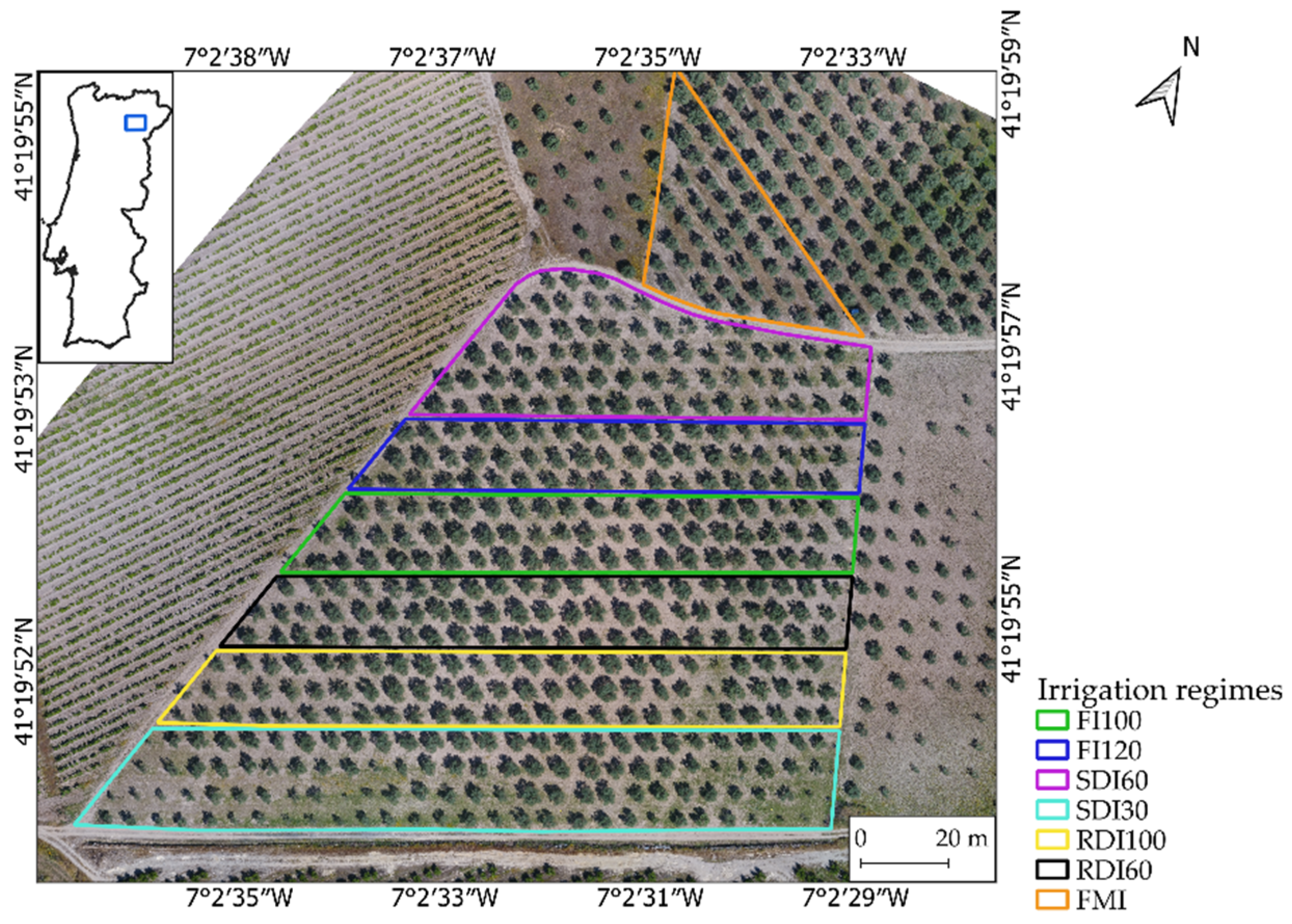
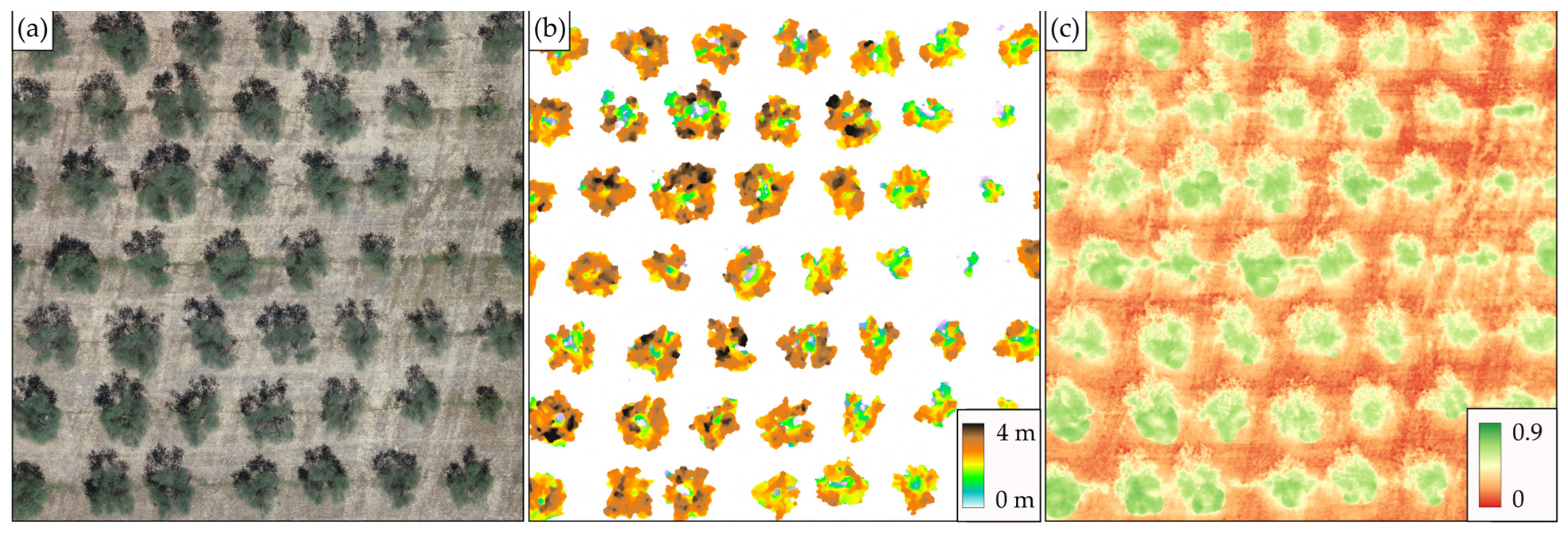

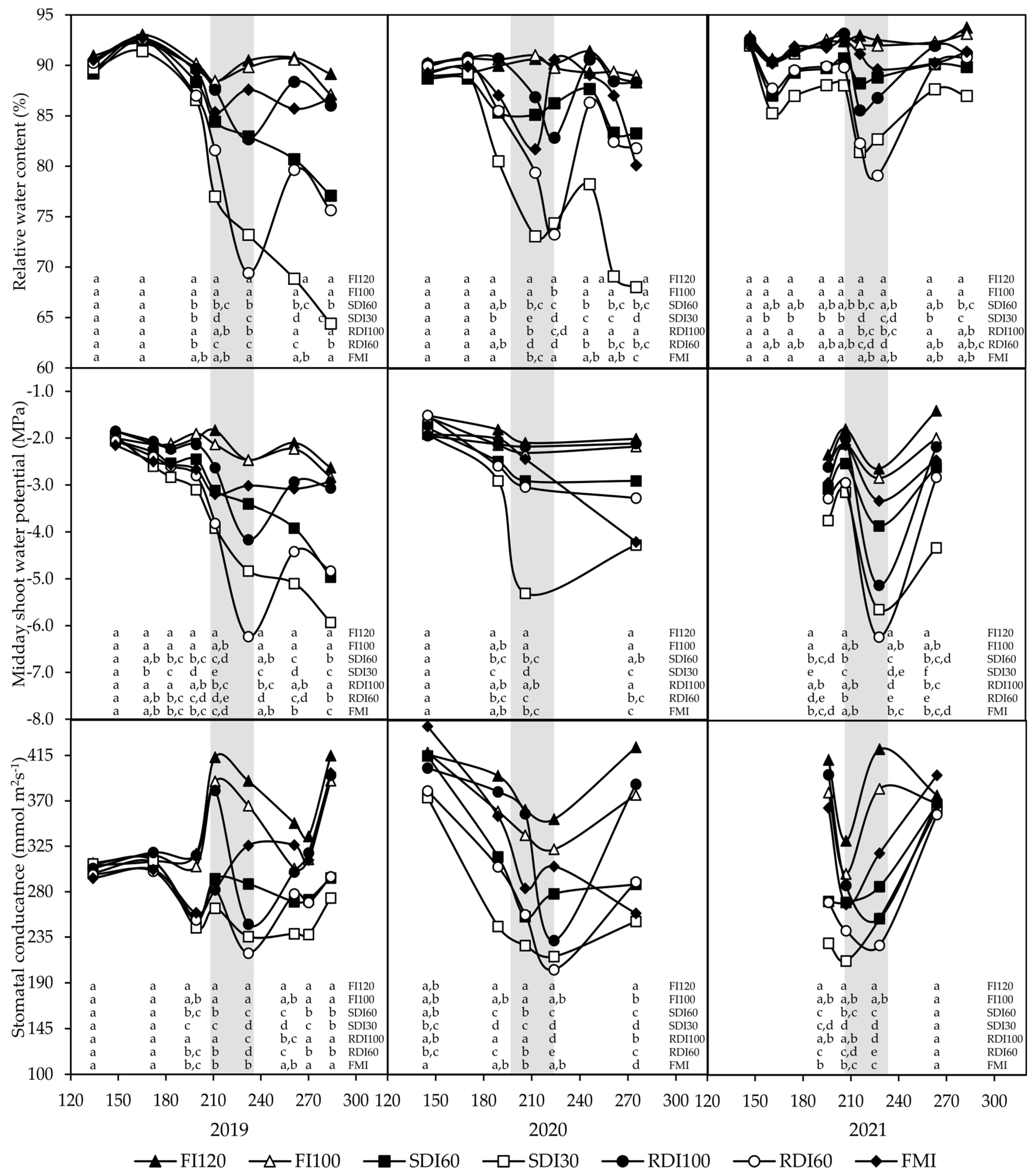
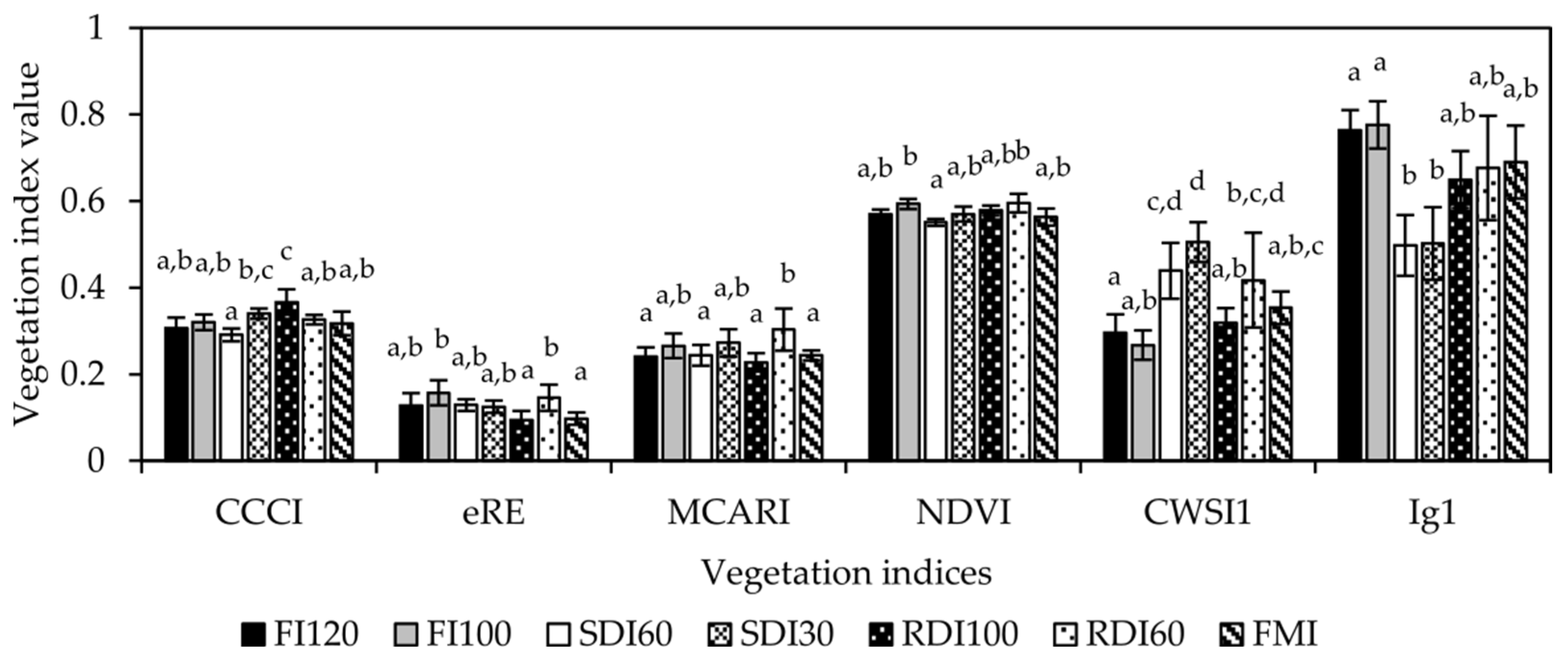
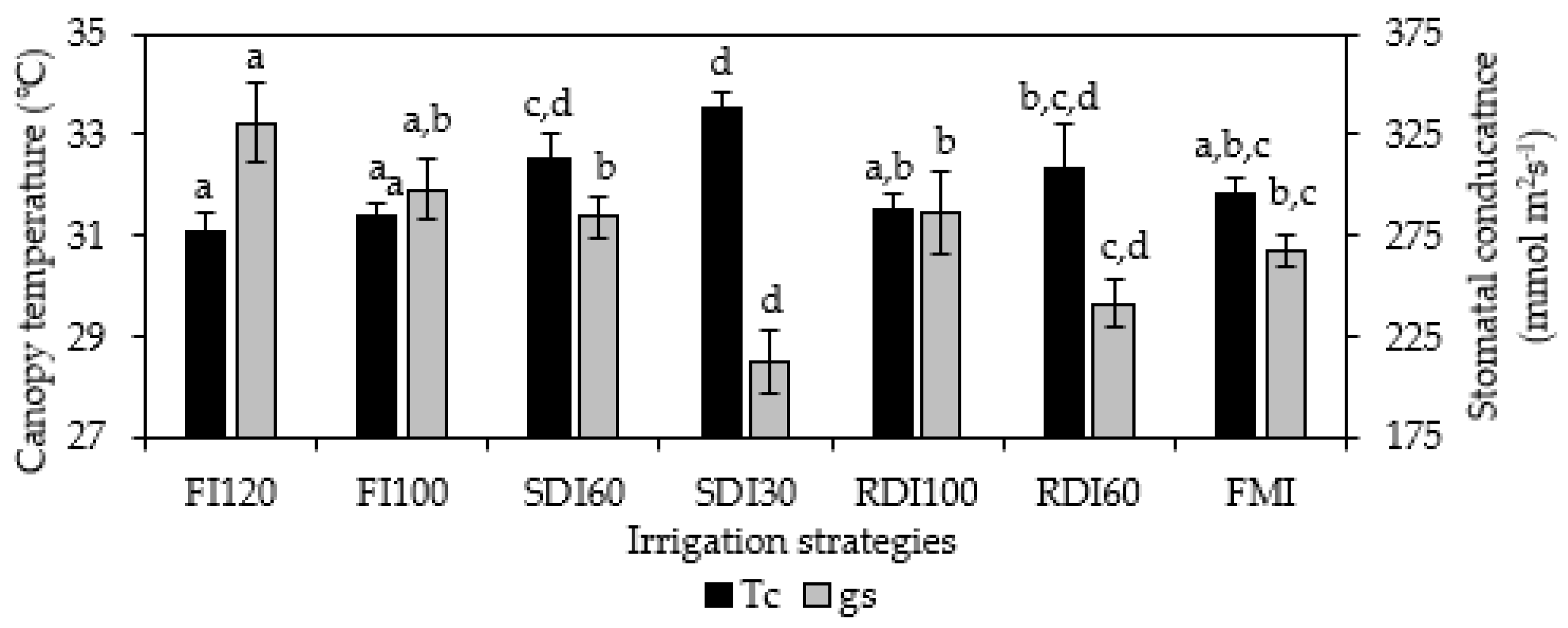
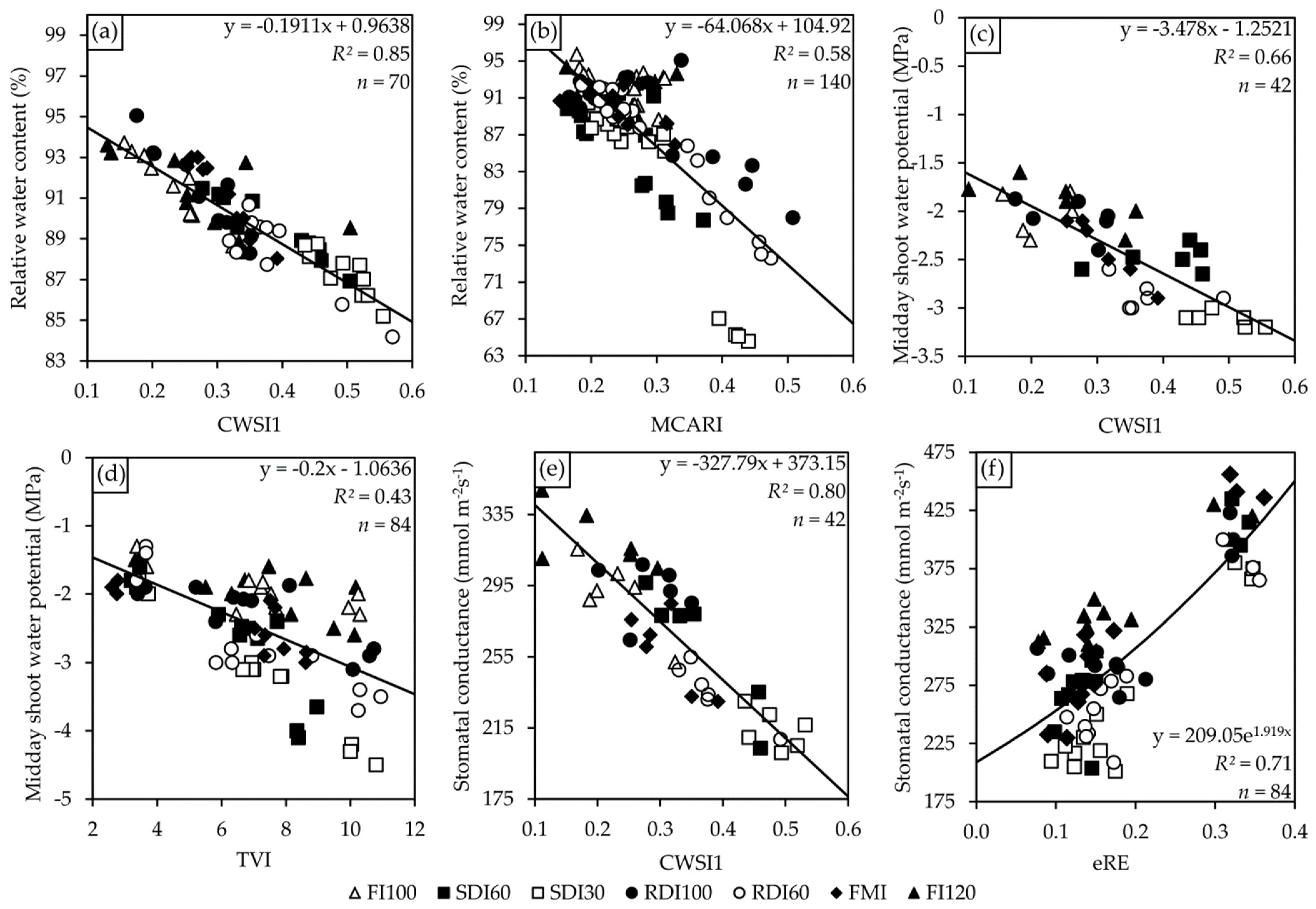

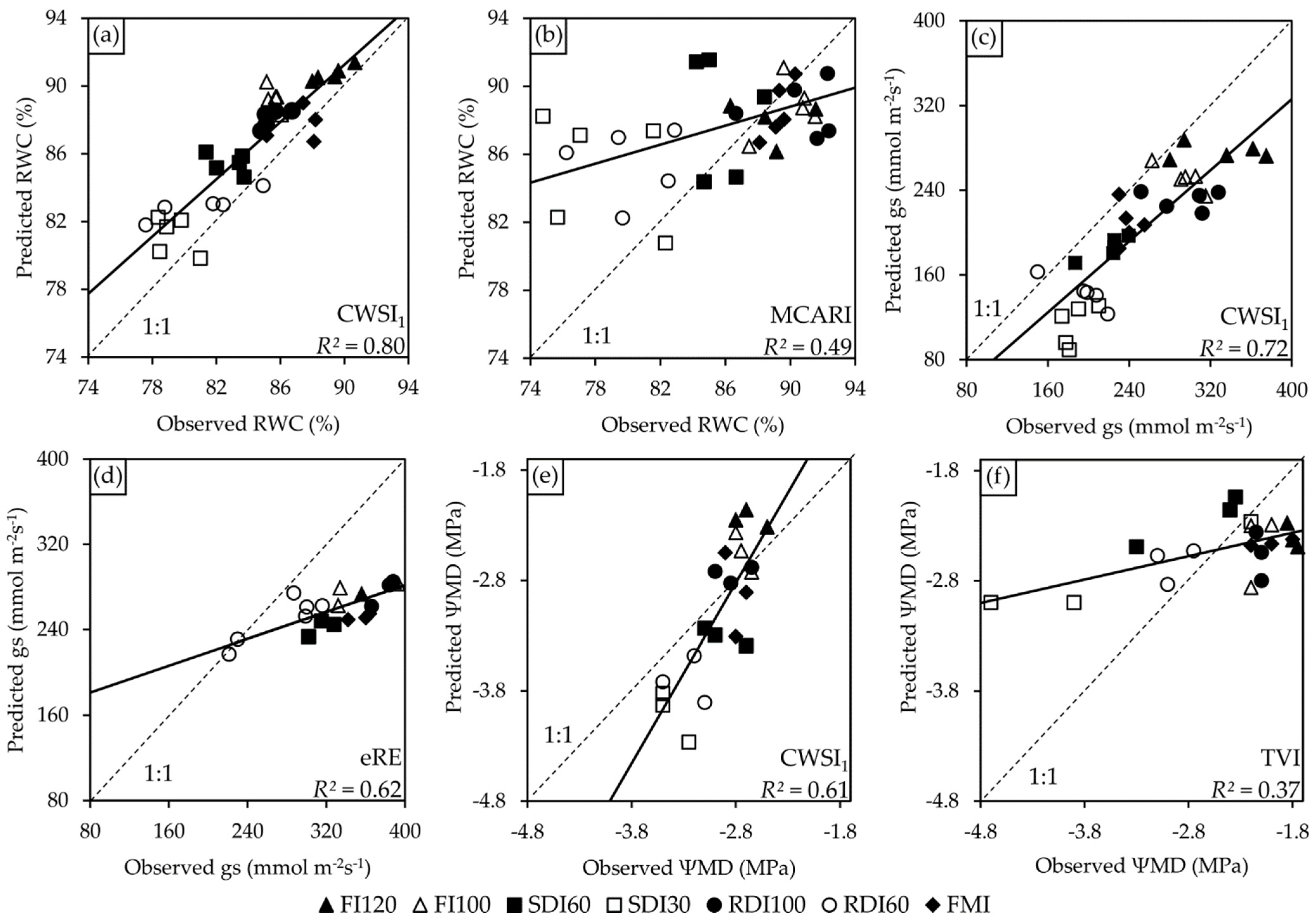
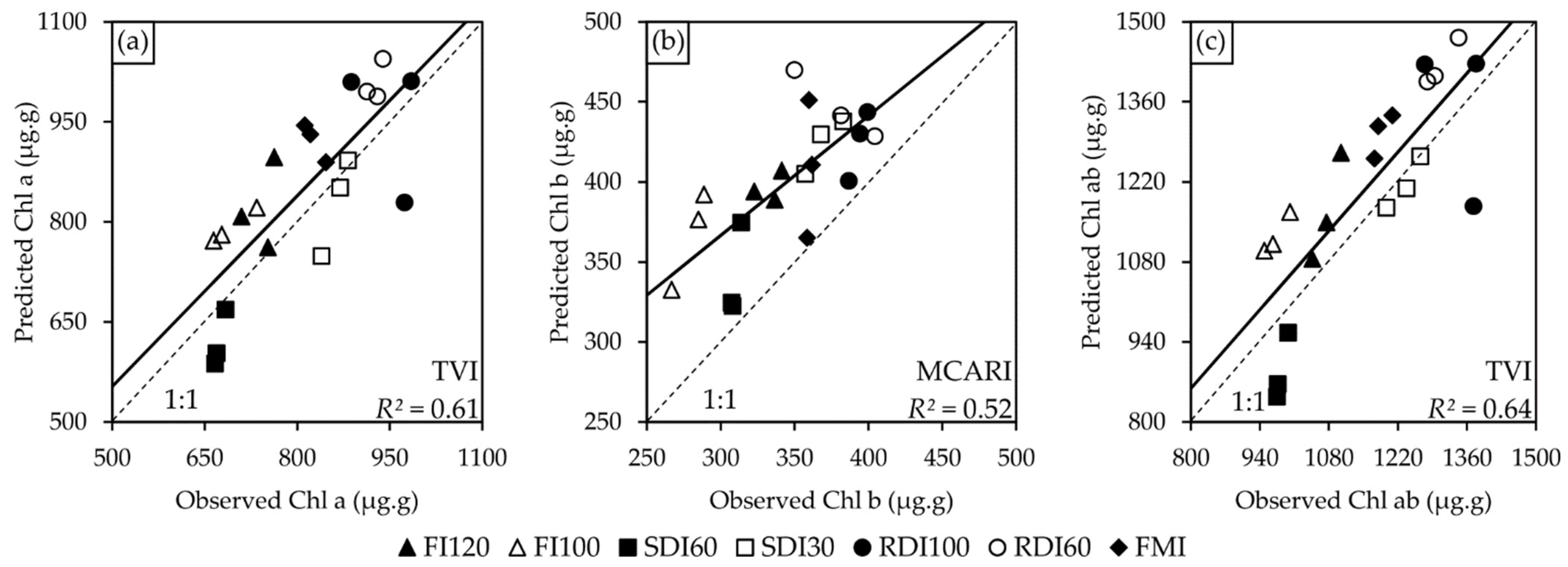
| DOY | Model Applicability | Data Type | Platform |
|---|---|---|---|
| 253 (2018) | Prediction | TIR | eBee |
| 199 (2019) | Regression | RGB and MSP | Phantom 4 |
| TIR | eBee | ||
| 261 (2019) | Regression | RGB and MSP | Phantom 4 |
| 145 (2020) | Regression | RGB and MSP | Phantom 4 |
| 189 (2020) | Prediction | RGB and MSP | Phantom 4 |
| 207 (2021) | Regression | RGB and MSP | Phantom 4 |
| TIR | eBee |
| Index | Lower Temperature Limit Twet/∆T1 | Upper Temperature Limit Tdry/∆T3 |
|---|---|---|
| CWSI1 | Wet reference temperature | Dry reference temperature |
| CWSI2 | Wet reference temperature | Air temperature plus 3 °C |
| CWSI3 | Wet reference temperature | Severe-water stress canopy temperature |
| CWSI4 | Well-watered canopy temperature | Air temperature plus 3 °C |
| CWSI5 | Temperature difference of the well-watered canopy and air | 3 °C |
| Ig1 | Wet reference temperature | Dry reference temperature |
| Ig2 | Wet reference temperature | Air temperature plus 3 °C |
| Ig3 | Temperature difference of the well-watered canopy and air | 3 °C |
| DOY | Irrigation Strategy | Chl a (µg/g) | Chl b (µg/g) | Chl ab (µg/g) | Carotenoids (µg/g) |
|---|---|---|---|---|---|
| 199 (2019) | FI120 | 1244 ± 25 a | 589 ± 27 a | 1833 ± 14 a | 234 ± 7 a |
| FI100 | 976 ± 26 b | 315 ± 46 b | 1290 ± 65 b | 128 ± 24 c | |
| SDI60 | 860 ± 11 c | 314 ± 49 b | 1173 ± 50 b | 192 ± 8 a,b | |
| SDI30 | 567 ± 14 e | 276 ± 12 b | 843 ± 24 c | 111 ± 12 c | |
| RDI100 | 690 ± 20 d | 241 ± 46 b | 932 ± 74 c | 149 ± 25 b,c | |
| RDI60 | 799 ± 22 c | 379 ± 49 b | 1178 ± 47 b | 164 ± 15 b,c | |
| FMI | 977 ± 38 b | 267 ± 25 b | 1244 ± 66 b | 206 ± 40 a,b | |
| 207 (2021) | FI120 | 1275 ± 41 a | 452 ± 24 a | 1727 ± 38 a | 353 ± 8 a,b |
| FI100 | 1177 ± 42 a,b | 469 ± 42 a | 1647 ± 53 a,b | 361 ± 6 a,b | |
| SDI60 | 899 ± 17 d | 381 ± 8 a,b | 1279 ± 20 c,d | 330 ± 7 b | |
| SDI30 | 844 ± 28 d | 326 ± 10 b | 1179 ± 37 d | 288 ± 3 c | |
| RDI100 | 1073 ± 46 b,c | 465 ± 42 a | 1537 ± 58 a,b | 377 ± 21 a | |
| RDI60 | 1043 ± 54 c | 419 ± 25 a,b | 1462 ± 63 b,c | 378 ± 17 a | |
| FMI | 1085 ± 34 b,c | 430 ± 51 a,b | 1515 ± 63 b | 384 ± 21 a |
| Parameter | Index | Regression Model | n | R2 | MAE | RMSE | RE (%) |
|---|---|---|---|---|---|---|---|
| Water status indicators | |||||||
| RWC | CWSI1 | RWC = −0.1911 × CWSI1 + 0.9638 | 35 | 0.80 | 2.3 | 2.7 | 2.8 |
| MCARI | RWC = −0.6407 × MCARI + 1.0492 | 35 | 0.49 | 2.9 | 3.8 | 3.6 | |
| gs | CWSI1 | gs = −327.79 × CWSI1 + 373.15 | 35 | 0.72 | 51.7 | 59.7 | 15.1 |
| eRE | gs = 209.05 × exp (1.919 × eRE) | 35 | 0.62 | 73.3 | 81.5 | 20.7 | |
| ΨMD | CWSI1 | ΨMD = −3.478 × CWSI1—1.2521 | 21 | 0.61 | 0.4 | 0.4 | 12.2 |
| TVI | ΨMD = −0.2 × TVI—1.0636 | 21 | 0.37 | 0.5 | 0.6 | 20.3 | |
| Pigment content | |||||||
| Chl a | TVI | Chl a = 205.87 × exp (0.2151 × TVI) | 21 | 0.61 | 78.3 | 89.2 | 9.8 |
| Chl b | MCARI | Chl b = 128.01 × exp (4.4233 × MCARI) | 21 | 0.52 | 55.1 | 62.4 | 16.4 |
| Chl ab | TVI | Chl ab = 306.84 × exp (0.2077 × TVI) | 21 | 0.64 | 103.7 | 116.8 | 9.2 |
| Carotenoids | TVI | Carotenoids = 32.632 × exp (0.2934 × TVI) | 21 | 0.29 | 116.1 | 144.5 | 30.3 |
Disclaimer/Publisher’s Note: The statements, opinions and data contained in all publications are solely those of the individual author(s) and contributor(s) and not of MDPI and/or the editor(s). MDPI and/or the editor(s) disclaim responsibility for any injury to people or property resulting from any ideas, methods, instructions or products referred to in the content. |
© 2023 by the authors. Licensee MDPI, Basel, Switzerland. This article is an open access article distributed under the terms and conditions of the Creative Commons Attribution (CC BY) license (https://creativecommons.org/licenses/by/4.0/).
Share and Cite
Marques, P.; Pádua, L.; Sousa, J.J.; Fernandes-Silva, A. Assessing the Water Status and Leaf Pigment Content of Olive Trees: Evaluating the Potential and Feasibility of Unmanned Aerial Vehicle Multispectral and Thermal Data for Estimation Purposes. Remote Sens. 2023, 15, 4777. https://doi.org/10.3390/rs15194777
Marques P, Pádua L, Sousa JJ, Fernandes-Silva A. Assessing the Water Status and Leaf Pigment Content of Olive Trees: Evaluating the Potential and Feasibility of Unmanned Aerial Vehicle Multispectral and Thermal Data for Estimation Purposes. Remote Sensing. 2023; 15(19):4777. https://doi.org/10.3390/rs15194777
Chicago/Turabian StyleMarques, Pedro, Luís Pádua, Joaquim J. Sousa, and Anabela Fernandes-Silva. 2023. "Assessing the Water Status and Leaf Pigment Content of Olive Trees: Evaluating the Potential and Feasibility of Unmanned Aerial Vehicle Multispectral and Thermal Data for Estimation Purposes" Remote Sensing 15, no. 19: 4777. https://doi.org/10.3390/rs15194777
APA StyleMarques, P., Pádua, L., Sousa, J. J., & Fernandes-Silva, A. (2023). Assessing the Water Status and Leaf Pigment Content of Olive Trees: Evaluating the Potential and Feasibility of Unmanned Aerial Vehicle Multispectral and Thermal Data for Estimation Purposes. Remote Sensing, 15(19), 4777. https://doi.org/10.3390/rs15194777









